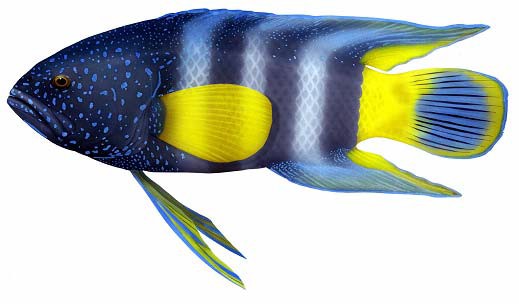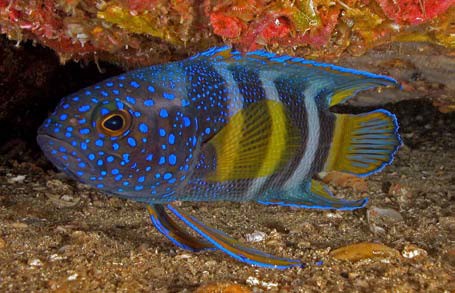
Eastern blue devil fish
Paraplesiops bleekeri

Eastern blue devil fish, Paraplesiops bleekeri, also known as Bleakers blue devil fish, are a shy, secretive fish found in caves, crevices and under ledges on inshore reefs and estuaries.
Eastern blue devil fish are distributed from southern Queensland to Montague Island on the NSW south coast.
Eastern blue devil fish are listed as a protected fish in NSW under the Fisheries Management Act 1994. Heavy penalties apply for taking or possessing them.
Description
Eastern blue devil fish are most easily recognised by their banded pattern of blue and white stripes on the body, blue spotted head, blue dorsal and anal fins, and yellow tail fin and base and pectoral fins. The pelvic fins and rear dorsal and anal fins are elongated. When blue devil fish spread these fins they overlap, making the fish appear larger. The fish grows to 40 cm in length.
Juveniles are generally a less colourful dusky brown with less prominent stripes or general blue colouration. However, some blue spots on the head and the gill covers and a blue band around the edges of all fins are still prominent.
Habitat and ecology
- Eastern blue devil fish are a benthic, inshore reef inhabitant. They occur in shallow waters in estuaries as well as in deep waters offshore ranging from 3 to 30 metres.
- Juveniles of the species are very rarely seen. The few juvenile individuals that have been observed were found in the back of narrow crevices.
- Eastern blue devil fish are solitary creatures that usually live alone in caves, crevices or under ledges during the day. They are most active at night. Little is known about their diet but they are known to feed on brittle stars.
- Males are thought to defend a territory in a cave or overhang in order to attract a mate and will drive other males away.
- The breeding season for Eastern blue devil fish is between the months of October and March. They lay groups of eggs glued to the underside of caves or ledges until they hatch. Free-swimming larvae, approximately 4 mm long, hatch from the eggs, and settle around reef areas when they have grown to about 10 mm.

Why are Eastern blue devil fish protected?
- Eastern blue devil fish are protected due to their natural rarity and low abundance.
- The predominant threat to Eastern blue devil fish is collection and trade for marine aquariums.
What conservation actions are underway?
- Protecting benthic estuarine and rocky offshore reef habitats to protect breeding populations of Eastern blue devil fish.
- Eastern blue devil fish habitat is located in a number of protected areas in NSW including the Solitary Islands Marine Park, Port Stephens – Great Lakes Marine Park, Jervis Bay Marine Park, Long Reef Aquatic Reserve and Bushrangers Bay Aquatic Reserve.
- Maintaining bans on taking Eastern blue devil fish in NSW and protecting them from illegal removal.
- Educating fishers on the best ways to return any incidentally caught Eastern blue devil fish to the water.
Legal implications
Taking or possessing Eastern blue devil fish (or any other species of protected fish) is an offence and heavy penalties apply. For corporations these penalties can include fines of up to
$55 000 while individuals can face fines of up to $11 000 and up to 3 months in prison.
For further information
For more information on general fishing regulations check with your local fisheries office or visit www.dpi.nsw.gov.au/fisheries
To contact your local NSW DPI Fisheries Office visit https://www.dpi.nsw.gov.au/contact-us/contact-a-dpi-fisheries-officer or phone 1300 550 474.
Bibliography and further reading
Hoese DF & Kuiter RH 1984, ‘A revision of the Australian fish genus Paraplesiops with notes on other Australian genera’, Records of the Australian Museum 36: 7–18.
Hutchins B & Swainston R 1986, Sea fishes of southern Australia. Complete field guide for anglers and divers, Swainston Publishing.
Kuiter RH 1993, Coastal fishes of south-eastern Australia, Crawford House Press, 437 pp.
Neira FJ, Miskiewicz AG & Trnski T 1998, Larvae of temperate Australian fishes: laboratory guide for larval fish identification, University of Western Australia Press, 474 pp.

